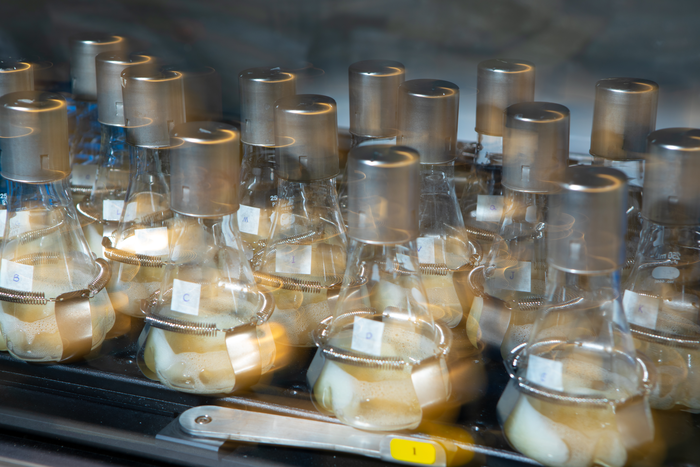Reviewed by Alex SmithNov 23 2021
Converting sugar into hydrocarbons found in gasoline sounds like futuristic alchemy. But that is precisely what researchers have accomplished.
 Genetically engineered bacteria can convert glucose into a fatty acid, which can then be transformed into hydrocarbons called olefins. To grow such bacteria, scientists add the microbes to flasks filled with nutrients (the yellow broth) and shake them in an incubator to encourage oxygen flow (Image Credit: Douglas Levere / University at Buffalo).
Genetically engineered bacteria can convert glucose into a fatty acid, which can then be transformed into hydrocarbons called olefins. To grow such bacteria, scientists add the microbes to flasks filled with nutrients (the yellow broth) and shake them in an incubator to encourage oxygen flow (Image Credit: Douglas Levere / University at Buffalo).
In a study featured in the journal Nature Chemistry, scientists describe harnessing the marvels of chemistry and biology to change glucose (a type of sugar) into olefins (a type of hydrocarbon, and one of the numerous types of molecules that constitute gasoline).
The study was headed by biochemists Zhen Q. Wang at the University at Buffalo and Michelle C. Y. Chang at the University of California, Berkeley.
The research, published on November 22nd, highlights the progress in efforts to produce sustainable biofuels.
Olefins include a small percentage of the molecules in gasoline as it is presently prepared, but the process the researchers formulated could probably be modified in the future to produce other types of hydrocarbons as well, such as some of the other constituents of gasoline, Wang says. She also expresses that olefins can be used in non-fuel applications, as they are employed in industrial lubricants and as precursors for manufacturing plastics.
A Two-Step Process Using Sugar-Eating Microbes and a Catalyst
To carry out the study, the scientists started by feeding glucose to strains of E. coli that do not cause a health hazard to humans.
These microbes are sugar junkies, even worse than our kids.
Zhen Q. Wang, PhD, Biochemist and Assistant Professor of Biological Sciences, College of Arts and Sciences, University at Buffalo
The E. coli in the experiments were genetically created to yield a group of four enzymes that turn glucose into compounds known as 3-hydroxy fatty acids. As the bacteria ate the glucose, they also began to create the fatty acids.
To finish the transformation, the researchers used a catalyst known as niobium pentoxide (Nb2O5) to cut off undesirable parts of the fatty acids in a chemical method, producing the end product: the olefins.
The team recognized the enzymes and catalyst using trial and error method, testing various molecules with properties that helped with the operations at hand.
We combined what biology can do the best with what chemistry can do the best, and we put them together to create this two-step process. Using this method, we were able to make olefins directly from glucose.
Zhen Q. Wang, PhD, Biochemist and Assistant Professor of Biological Sciences, College of Arts and Sciences, University at Buffalo
Glucose Comes from Photosynthesis, Which Pulls CO2 Out of the Air
“Making biofuels from renewable resources like glucose has great potential to advance green energy technology,” Wang says.
Glucose is produced by plants through photosynthesis, which turns carbon dioxide (CO2) and water into oxygen and sugar. So the carbon in the glucose—and later the olefins—is actually from carbon dioxide that has been pulled out of the atmosphere.
Zhen Q. Wang, PhD, Biochemist and Assistant Professor of Biological Sciences, College of Arts and Sciences, University at Buffalo
Further study is required, however, to comprehend the advantages of the new technique and whether it can be expanded efficiently for creating biofuels or for other purposes. One of the primary questions that will have to be answered is how much energy is consumed in the process of creating the olefins; if the energy cost is very high, the technology would have to be enhanced to be beneficial on a mass scale.
Researchers also want to increase the yield. At present, it takes 100 glucose molecules to create around 8 olefin molecules, Wang states. She is keen to better that ratio, with an emphasis on coaxing the E. coli to yield more of the 3-hydroxy fatty acids for every gram of glucose absorbed.
The study’s co-authors in Nature Chemistry include Wang; Chang; Heng Song, PhD, at UC Berkeley and Wuhan University in China; Edward J. Koleski, Noritaka Hara, PhD, and Yejin Min at UC Berkeley; Dae Sung Park, PhD, Gaurav Kumar, PhD, and Paul J. Dauenhauer, PhD, at the University of Minnesota (Park is now at the Korea Research Institute of Chemical Technology).
The study received funding support from the U.S. National Science Foundation; the Research Foundation for the State University of New York; and the Camille and Henry Dreyfus Postdoctoral Program in Environmental Chemistry.
Journal Reference:
Wang, Z.Q., et al. (2021) A dual cellular–heterogeneous catalyst strategy for the production of olefins from glucose. Nature Chemistry. doi.org/10.1038/s41557-021-00820-0.